Please note: You are viewing
the unstyled version of this website. Either your browser does not support CSS
(cascading style sheets) or it has been disabled. Skip
navigation.
Question 1: Is the sea around Iceland very different from the sea around Greenland? Answer: The sea around Iceland is indeed quite different from that around Greenland. Along most of the coast of Greenland a current that carries very cold and fresh polar water and large quantities of ice originating from the Arctic Ocean to the south. This current is called the “East Greenland Current” east of Greenland, and the “West Greenland Current” west of Greenland after it has turned around Cape Farewell. The currents around Iceland, on the other hand, are mainly branches of the North Atlantic Current, which is essentially an extension of the Gulf Stream. As a result, the sea around Iceland tends to be relatively warm and salty. Answered by Kjetil Våge, Physical Scientist 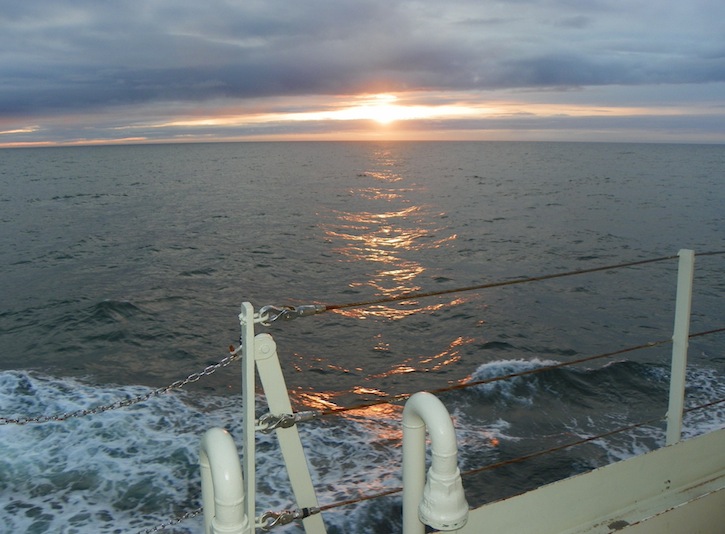 View of the sea off Iceland at the end of our first day after leaving Reykjavik. © Pat Keoughan 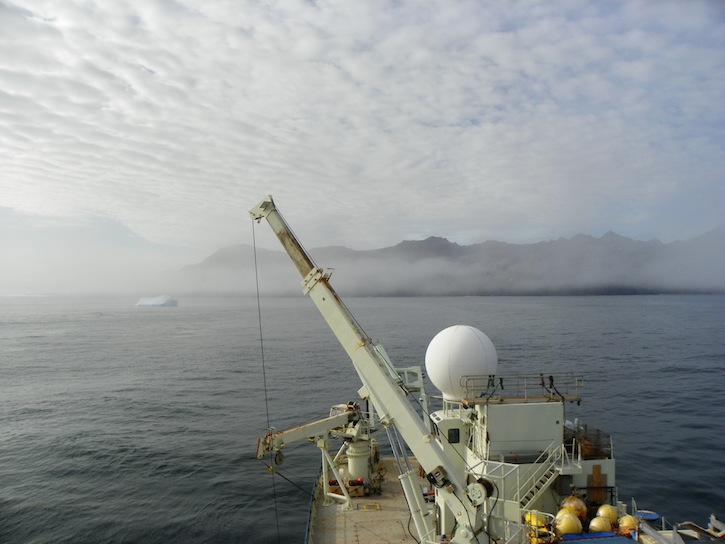 The sea off Greenland was foggy and cold enough for icebergs. © Pat Keoughan Question 2: What would happen if the current changed? Answer: Hundreds of currents—some warm some cold, some on the surface some in the depths—course through the body of the ocean like blood vessels in the human body. These are permanent currents. Sure, they vary somewhat in direction and speed in the short term, but they’ve been flowing permanently in the same direction since the continents moved into their present positions. They are vital to our climate because they move heat from where there is too much, the tropics, to the where there is too little, the high latitudes, and back again. Therefore, they moderate the climate, thus making large segments of the globe habitable that otherwise would be too extreme (hot or cold) to support a broad range of life. If somehow the currents changed, then our climate would also change, and rather quickly according to most computer simulations. Generally speaking, as long as the winds continue to blow and the Earth to rotate, then currents will remain unchanged. However, one of the most vulnerable arcs in the ocean-circulation system is right here in the Nordic Seas. This is largely because of the Greenland Ice Sheet. This enormous glacier covering Greenland, the largest island in the world, several miles deep, consists of freshwater ice. We know without doubt that the ice sheet is melting due to global warming, pouring unprecedented quantities of freshwater into the ocean. This could alter the ocean’s salinity in the region of our study. In order for the circulation to continue as we know it, seawater must sink (convection is the fancy term) in the Nordic Seas. Freshwater dilutes salinity, making the seawater lighter, less prone to sink, more likely to freeze on the surface. If that happens to a great enough extent, then climate disaster will result, a new ice age, some computer simulations suggest. No one knows for sure, but by continuing to dump heat-trapping gas into the atmosphere, we’re conducting a great experiment to find out. Answered by Dallas Murphy, Writer, Outreach Team Question 3: Can we do anything to prevent it from changing? Answer: To prevent man-made changes to the atmosphere from changing the ocean circulation, we have to encourage and support our governments to cut back on the use of fossil fuels, especially from our transportation and power plants. We have to reduce the amount of greenhouse gasses we pump into the atmosphere and end the destruction of natural carbon sinks such as forests. Answered by Pat Keoughan, Outreach Team Question 4: How many mooring balls do you put in the ocean and how far between are they? Answer: We deployed twelve new moorings across the Denmark Strait. They are placed about 10 to 20km apart. Answered by Chief Scientist, Dr. Bob and Anton Zaferes, Knorr Science Technician. 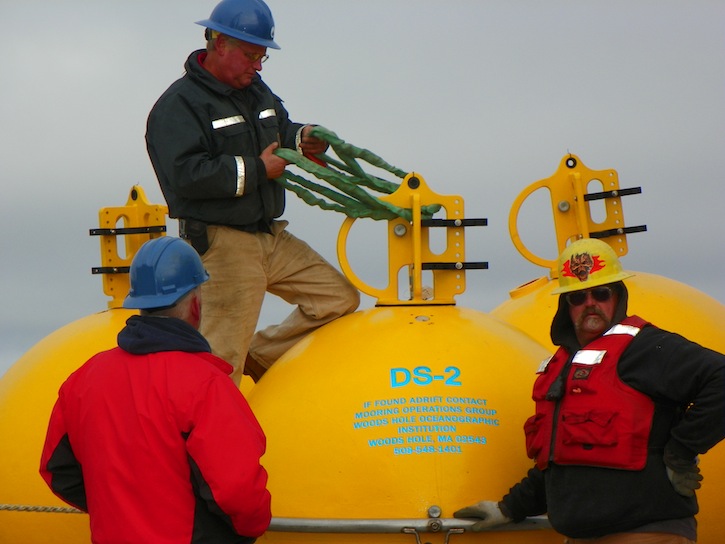 Mooring technician John Kemp, with the help of mooring team member Jim Ryder and bosun Kyle, readies one of the floats to be lifted by crane and moved to the edge of the transom. From there it will be lowered into the ocean. © Pat Keoughan 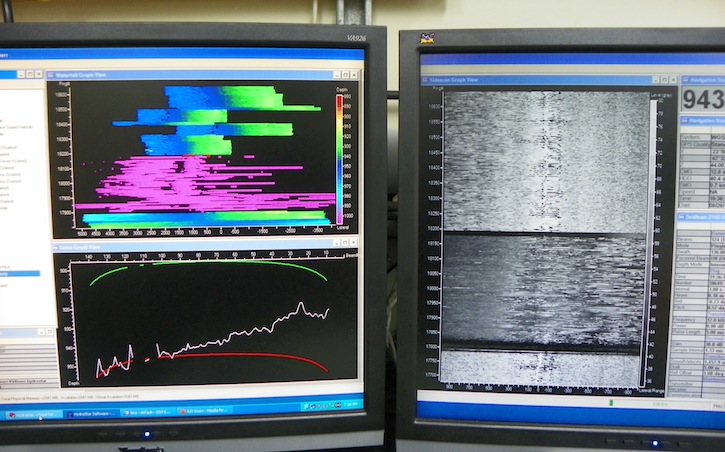 These computer pictures produced by a multibeam sonar give the scientists 3D pictures of the ocean bottom to determine the best spot to place each mooring. © Pat Keoughan These computer pictures produced by a multibeam sonar give the scientists 3D pictures of the ocean bottom to determine the best spot to place each mooring. © Pat Keoughan Question 5: Why did you invite some school students to be involved with this project? Answer: This is the third research cruise in which Dr. Bob has had an outreach team accompany him as part of the science party aboard. Through this team he is able to inform the general public and raise their consciousness as to what research is being done in Arctic waters, how and why, and its importance to better understanding of the processes of global climate change. Students, such as you, involved in learning about ocean research in real time through our website and by asking questions, will bring the knowledge you acquire from this experience with you as your generation ages. This will help you make informed decisions about climate change and what needs to be done. Perhaps some of you will be inspired to make science your career choice. In this time of misinformation about climate change, the more the general population understands about the science behind it, the better chance we have to make a positive difference in how we deal with it. Answered by Pat Keoughan, Outreach Team Question 6: How fast can your ship go? Answer: The top speed of the Knorr is about 13 knots. The term "knot" means nautical miles per hour, so 13 knots translates to approximately 24 km/hour. But we hardly ever go that fast. For instance, if the weather starts getting rough, or if it is foggy outside, then often times we only go 5-6 knots. But there is something else to consider. We can be traveling at a certain speed over the water, but actually be going much slower or faster relative to the ocean bottom. As an extreme example, consider that the Gulf Stream (one of the most powerful currents in the world) can go as fast as 5 knots. This means that if our engines are running at full speed we could reach 18 knots (or 33 km/hour). This is fast for a research ship, but not compared to a car! Answered by Chief Scientist Dr. Bob 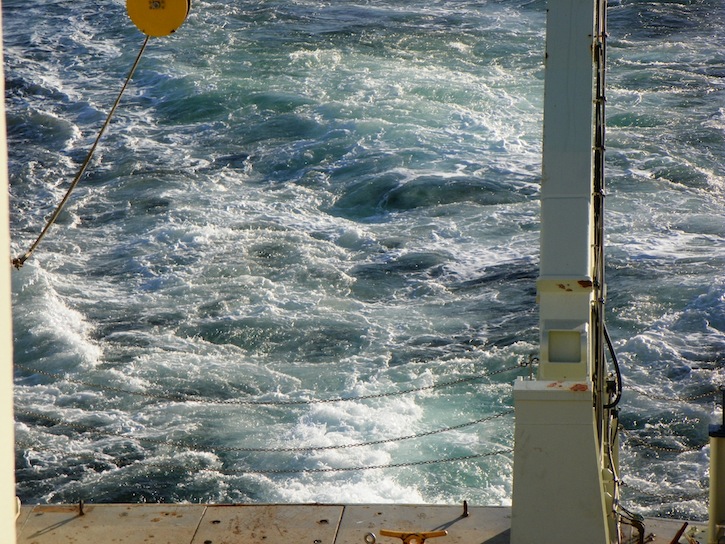 The wake the KNORR leaves is gentle or churning as in this photo depending on its speed. © Pat Keoughan The wake the KNORR leaves is gentle or churning as in this photo depending on its speed. © Pat Keoughan Last updated: December 27, 2011 | |||||||||||
Copyright ©2007 Woods Hole Oceanographic Institution, All Rights Reserved, Privacy Policy. | |||||||||||


